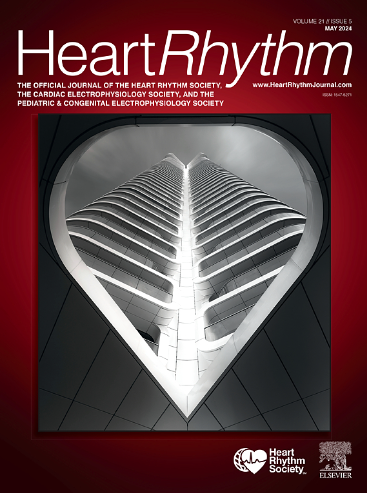伴有旁观者隐匿性结/结筋膜通路的房室结再发性心动过速的发病率和特征。
IF 5.6
2区 医学
Q1 CARDIAC & CARDIOVASCULAR SYSTEMS
引用次数: 0
摘要
背景:隐匿性结/结筋膜(NV/NF)通路主要是连接右心室/右束支(RBB)和慢通路(SP)的旁路、逆行旁路,可在房室结性再发性心动过速(AVNRT)患者中观察到。然而,其发病率及其对起搏操作的反应特征尚未得到充分评估:本研究调查了带有旁观者 NV/NF 通路的房室返流性心动过速的发生率和特征:我们回顾性分析了 153 例接受导管消融术的连续房室神经阻滞患者。结果:3 名患者(3.0%)接受了导管消融术:三名患者(3.0%)有旁观者隐藏的 NV/NF 通路,所有这些通路都与 SP 相连。两名患者的心动过速是典型的 SP/ 快速通路(FP)型 AVNRT,一名患者的心动过速是不典型的 FP/SP 型 AVNRT。在所有病例中,His 难治性室外刺激(VES)通过 NV/NF 通路延迟复位房室传导阻滞。早期阶段的心室超速起搏(VOP)也会延迟复位房室营养回流。较早的 VES 和中期的 VOP 不能重置心动过速,而较早的 VES 和较晚的 VOP 则通过 RBB-His 传导提前重置心动过速:旁观者 NV/NF 通路在房室缺血性心动过速患者中并不罕见。有旁路 NV/NF 通路的房室缺血性心动过速的 VES 和 VOP 具有两阶段复位现象的特征:最初的短暂复位通过 NV/NF 通路延迟,晚期的复位通过 RBB-His 传导提前。本文章由计算机程序翻译,如有差异,请以英文原文为准。

Prevalence and characteristics of atrioventricular nodal reentrant tachycardia with a bystander concealed nodoventricular/nodofascicular pathway
Background
The concealed nodoventricular/nodofascicular (NV/NF) pathway is mostly a bystander, retrograde bypass tract connecting the right ventricle/right bundle branch (RBB) and slow pathway that is observed in patients with atrioventricular nodal reentrant tachycardia (AVNRT). However, its prevalence and characteristics in response to pacing maneuvers have not been fully evaluated.
Objective
This study investigated the prevalence and characteristics of AVNRT with a bystander NV/NF pathway.
Methods
We retrospectively reviewed 153 consecutive patients undergoing catheter ablation of AVNRT. After exclusion of 52 patients with inadequate electrophysiologic data, 101 patients composed the study population.
Results
Three patients (3.0%) had bystander concealed NV/NF pathways, all of which were connected to the slow pathway. The tachycardia was typical slow pathway/fast pathway AVNRT in 2 patients and atypical fast pathway/slow pathway AVNRT in 1 patient. In all cases, His-refractory ventricular extra-stimuli (VES) reset the AVNRTs with delay through the NV/NF pathways. Ventricular overdrive pacing (VOP) in the early phase also reset the AVNRT with delay. Earlier VES and middle phase of VOP did not reset the tachycardia, and further earlier VES and late phase of VOP reset the tachycardia with advance through the RBB-His conduction.
Conclusion
A bystander NV/NF pathway was not rare in patients with AVNRT. The VES and VOP for the AVNRTs with the bystander NV/NF pathways were characterized by the 2-phase resetting phenomenon: initial transient resetting with delay through the NV/NF pathway, and late resetting with advance through the RBB-His conduction.
求助全文
通过发布文献求助,成功后即可免费获取论文全文。
去求助
来源期刊

Heart rhythm
医学-心血管系统
CiteScore
10.50
自引率
5.50%
发文量
1465
审稿时长
24 days
期刊介绍:
HeartRhythm, the official Journal of the Heart Rhythm Society and the Cardiac Electrophysiology Society, is a unique journal for fundamental discovery and clinical applicability.
HeartRhythm integrates the entire cardiac electrophysiology (EP) community from basic and clinical academic researchers, private practitioners, engineers, allied professionals, industry, and trainees, all of whom are vital and interdependent members of our EP community.
The Heart Rhythm Society is the international leader in science, education, and advocacy for cardiac arrhythmia professionals and patients, and the primary information resource on heart rhythm disorders. Its mission is to improve the care of patients by promoting research, education, and optimal health care policies and standards.
 求助内容:
求助内容: 应助结果提醒方式:
应助结果提醒方式:


